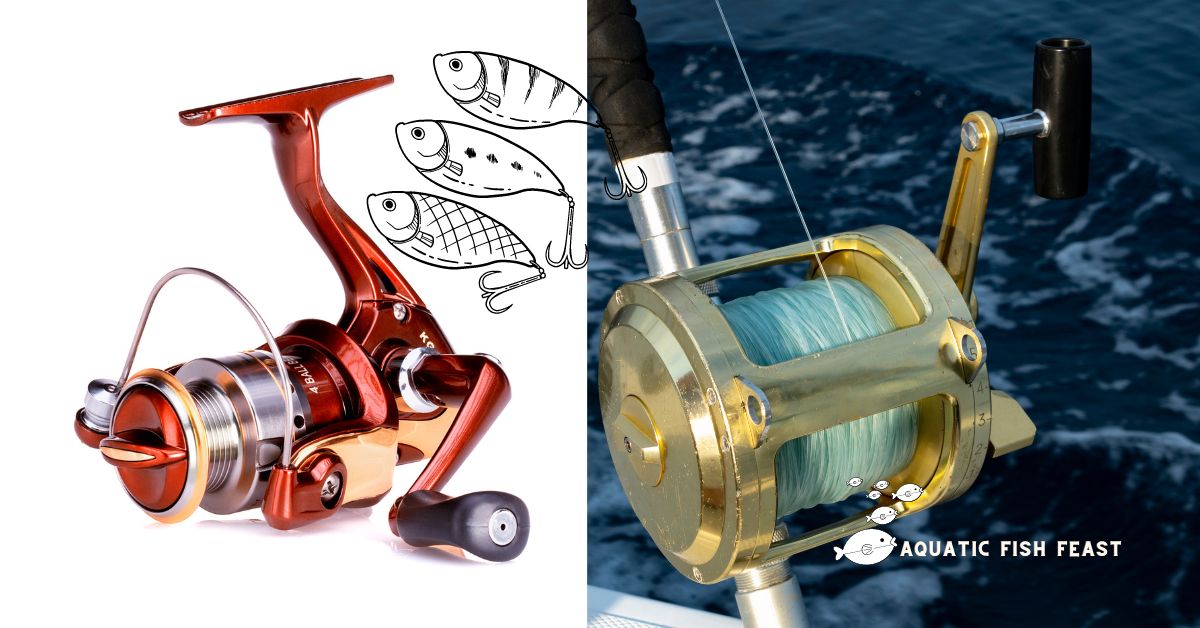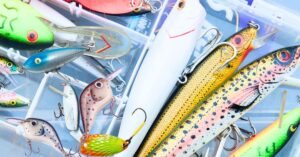Fishing reel types refer to the various categories of fishing reels, each designed for specific fishing methods and environments.
These include spinning reels, baitcasting reels, spin cast reels, fly reels, and more, each offering unique features and advantages.
And this is all part of the fishing process, which establishes a connection with nature.
You can be sure to use the right fishing reel types to multiply and increase your chances of catching more fish.
In this post, we’ll discuss the various fishing reel types and their particular applications to help you make wise decisions about your fishing trips.
Let’s explore the different fishing reel types and their specific uses now!
Table of Contents
Overview of Fishing Reel Types
Fishing reels come in different sizes and shapes, each designed for specific fishing scenarios. Understanding these types is important for choosing the right reel for your needs.
The main types of fishing reels include:
- Spinning Reels: Known for their versatility and ease of use.
- Baitcasting Reels: Preferred for precision and power.
- Spincast Reels: Ideal for beginners due to their simplicity.
- Fly Reels: Specifically designed for fly fishing.
- Trolling Reels: Built for strength and high capacity.
Different Fishing Reel Types and Their Uses
1. Spinning Reels: Versatility and Ease
Spinning reels, also known as open-face reels, are among the most popular and versatile reels used by anglers of all levels.
They feature a fixed spool underneath the rod and a bail arm that guides the line onto the spool.
Uses: Ideal for light to medium fishing, spinning reels are perfect for catching small to medium-sized fish such as bass, trout, and walleye. They are excellent for casting light lures and baits.
Best For: Light to medium freshwater fishing, inshore saltwater fishing.
Techniques: Casting light lures, finesse fishing, vertical jigging.
Advantages: Easy to use, suitable for a variety of species, minimal backlash.
Drawbacks: Less accurate than bait casters, limited power for large fish.
2. Baitcasting Reels: Precision and Power
Baitcasting reels, often used by experienced anglers. They have a revolving spool and are mounted on top of the rod.
These reels offer greater control and precision.
Uses: Baitcasting reels are suited for targeting larger fish and for techniques that require heavy lures and lines. They are commonly used for bass fishing and saltwater fishing.
Best For: Freshwater and saltwater fishing for larger species.
Techniques: Accurate casting, heavy lures, flipping, and pitching.
Advantages: Greater casting accuracy, powerful drag systems, ideal for big fish.
Drawbacks: Steeper learning curve, prone to backlash.
3. Spincast Reels: Simplicity and Accessibility
The spin cast reels are known for their simplicity and ease of use.
They feature a closed face, with the line protected inside a nose cone and a button that releases the line during casting.
Uses: Perfect for beginners and children, spincast reels are best for small fish and light freshwater fishing. They are great for panfish and small trout.
Best For: Beginners, children, light freshwater fishing.
Techniques: Basic casting, simple retrieves.
Advantages: Very easy to use, minimal maintenance.
Drawbacks: Limited casting distance, less durable, not suitable for large fish.
4. Fly Reels: Specialized and Elegant
The Fly reels are specifically designed for fly fishing, a technique where the weight of the line carries the hook through the air.
These reels are typically simple in design, with a large arbor for line storage.
Uses: Fly reels are used in freshwater and saltwater fly fishing, targeting species such as trout, salmon, and bonefish.
Best For: Fly fishing in freshwater and saltwater.
Techniques: Casting fly lines and retrieving lines during fights.
Advantages: Simple design, large line capacity, smooth drag systems.
Drawbacks: Limited to fly fishing can be expensive.
5. Trolling Reels: Strength and Capacity
Trolling reels are robust and designed for trolling, a method of fishing where the bait is drawn through the water behind a boat.
They have high line capacity and strong drag systems.
Uses: Ideal for catching large saltwater species like tuna, marlin, and sailfish, as well as freshwater giants like muskies and lake trout.
Best For: Deep-sea fishing, large freshwater species.
Techniques: Trolling baits or lures behind a moving boat.
Advantages: High line capacity, strong drag systems, durable.
Drawbacks: Bulky, requires specialized rods and setups.
Open Face Fishing Reel Types
Spinning Reels
Spinning reels, often referred to as open-face reels, are renowned for their versatility and user-friendly design. They are ideal for anglers of all skill levels.
Features: Fixed spool, bail arm for line management, anti-reverse mechanism.
Advantages: Ease of use, minimal backlash, versatile for various fishing conditions.
Best For: Beginners to advanced anglers, light to medium fishing.
Saltwater Fishing Reel Types
Saltwater fishing presents unique challenges, requiring reels that can withstand corrosive environments and handle large, powerful fish.
Spinning Reels for Saltwater
Features: Corrosion-resistant materials, sealed drag systems, high line capacity.
Advantages: Versatile, easy to use, durable against saltwater conditions.
Best For: Inshore and light offshore fishing, targeting species like redfish, snook, and small tuna.
Baitcasting Reels for Saltwater
Features: Robust construction, high drag capacity, corrosion-resistant components.
Advantages: Precision casting, powerful drag systems, suitable for larger fish.
Best For: Inshore and offshore fishing, targeting species like tarpon, sailfish, and large tuna.
Trolling Reels for Saltwater
Features: High line capacity, powerful drag systems, durable construction.
Advantages: Ideal for deep-sea fishing, can handle large, strong fish.
Best For: Offshore trolling for species like marlin, swordfish, and large tuna.
Fishing Reel Types: Pros and Cons
1. Spinning Reels
Pros:
- User-friendly
- Versatile for different fishing styles
- Minimal backlash
Cons:
- Less accurate than baitcasters
- Limited power for very large fish
2. Baitcasting Reels
Pros:
- High casting accuracy
- Powerful drag systems
- Ideal for large fish
Cons:
- Requires skill to avoid backlash
- More expensive
3. Spincast Reels
Pros:
- Extremely easy to use
- Minimal maintenance
- Great for beginners
Cons:
- Limited casting distance
- Less durable
- Not suitable for large fish
4. Fly Reels
Pros:
- Smooth drag systems
- Large line capacity
- Simple design
Cons:
- Limited to fly fishing
- Can be expensive
5. Trolling Reels
Pros:
- High line capacity
- Strong drag systems
- Durable
Cons:
- Bulky
- Requires specialized rods and setups
Recommendations Based on Different Fishing Needs
For Beginners
- Spincast Reels: Easy to use, low maintenance, perfect for learning the basics.
For Versatility
- Spinning Reels: These are suitable for various fishing styles and species.
For Precision
- Baitcasting Reels: Offers accuracy and power, ideal for experienced anglers targeting larger fish.
For Specialized Fishing
- Fly Reels: Designed specifically for fly fishing, great for freshwater and saltwater fly fishing.
Using for Big Game Fishing
- Trolling Reels: Built to handle large, powerful fish in deep-sea environments.
Summary Table of All Fishing Reel Types
| Reel Type | Best For | Pros | Cons |
|---|---|---|---|
| Spinning Reels | Light to medium fishing | User-friendly, versatile | Less accurate, limited power |
| Baitcasting Reels | Large fish, heavy lures | High accuracy, powerful drag | Requires skill, prone to backlash |
| Spincast Reels | Beginners, light freshwater fishing | Easy to use, low maintenance | Limited distance, less durable |
| Fly Reels | Fly fishing | Smooth drag, large capacity | Limited to fly fishing, expensive |
| Trolling Reels | Deep-sea fishing, large fish | High capacity, strong drag | Bulky, needs specialized setups |
Old Fishing Reel Types
Fishing reels have improved significantly over the years. Here’s a look at some vintage reel types and their evolution.
Vintage Baitcasting Reels
Originally made from brass and other metals, these reels were manually operated and required significant skill. Over time, materials and mechanisms improved, leading to modern baitcasting reels.
Classic Spinning Reels
Early spinning reels featured simpler designs with basic drag systems. Modern advancements have introduced more durable materials, smoother drags, and better line management systems.
Antique Fly Reels
Vintage fly reels were often handcrafted from materials like wood and brass. Today’s fly reels benefit from lightweight materials and advanced drag systems, making them more efficient and durable.
Fly Fishing Reel Types
Fly fishing requires specialized equipment, and the fly reel is a crucial component. Here’s a detailed look at fly fishing reels and their specific characteristics.
Single-Action Fly Reels
The most common type of fly reel features a simple design where one turn of the handle equals one turn of the spool.
Uses: Suitable for most freshwater and saltwater fly fishing scenarios.
Advantages: Simple, reliable, and easy to maintain.
Multiplying Fly Reels
These reels offer a gear ratio that allows the spool to turn multiple times with each handle turn, providing faster line retrieval.
Uses: Ideal for situations where quick line retrieval is essential, such as when fishing for fast-swimming species.
Advantages: Faster line retrieval, useful in fast currents.
Automatic Fly Reels
The automatic fly reels have a spring-loaded mechanism that automatically retrieves the line when a trigger is pressed.
Uses: Helpful for beginners and those who prefer not to manually wind the line.
Advantages: Easy to use, quick line retrieval.
Drawbacks: More complex can be prone to mechanical issues.
Conclusion
You can be certain that choosing the right fishing reel types may really improve your fishing experience now that we have studied the various varieties and their applications.
Understanding the various types of fishing reels and how they are used can help you make a smart choice that corresponds with your fishing style and the type of fish you are aiming for.
Your choice of fish reel will surely influence the success of your fishing trip, regardless of your experience.
So, when choosing your fishing reel types, consider aspects such as power, accuracy, convenience of usage, and the particular fishing environment.
Other Articles:




